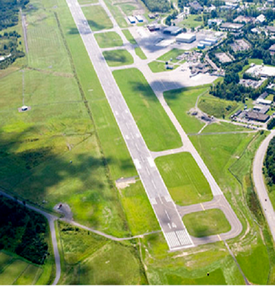 Managing wildlife on airports is a never-ending battle. This battle is fought two different ways, lethal and non-lethal. Most wildlife is attracted to airport environments because it typically holds what they crave, food, water, and shelter. As the population of humans increase and so does the love for land development, airports become more and more of a hotspot for birds and mammals to take refuge. One rule of thought is that the most effective way of managing wildlife on airports is to modify or remove the attractants so that wildlife avoids the airport all together. Non-lethal management practices are often referred to as hazing or habitat management. Unfortunately, this method can never be 100% successful because of the highly adaptable nature of most wildlife species. This makes it extremely difficult and a time intense task. This creates a huge problem for all airport operators since courts have determined that airport operators are responsible for keeping a safe, wildlife free facility, and is obligated to warn flight crews of any activity. Private companies like Loomacres Wildlife Management Inc. become extremely important and can be an airports best friend for supplying tactics and executing proper techniques to mitigate wildlife risks. The first step in implementing a wildlife management plan on airfields is to perform a risk assessment. If you do not have data already on file you can begin by observing the wildlife that is using the airport. Set up in different places at different times of the day and night and simply observe and report. This will paint a clear picture of what species may be living on the airfield or somehow getting into the airfield. Second continue collecting and analyzing wildlife strike data to identify the species struck by aircrafts. The last thing and most important is to run a report in the FAA Strike Database. Some will run this dating back to the last 10 years or more. This may sound like an extremely time-consuming process and for the most part it is. However, the data will be used to allocate resources once your WHMP is put into place. Airports that are typically at high risk and in much need of implanting a plan immediately usually have a history of high strike rates or tend to be located near lakes, rivers, or other large bodies of water attracting migratory waterfowl. Also, airports that have landfills near by will also be at higher risk of strikes at an alarming rate. These airports must implement a rather aggressive wildlife control program. Once a risk assessment is concluded the data is used to customize a WHMP (Wildlife Hazard Management Plan). A well-developed plan will outline not only strategies but also allocations of wildlife control resources and includes information on the following:
Although not all encompassing, the bullets summarize issues that are typically addressed in an airport wildlife management plan. The short term and long-term success of an airport wildlife control program is very much dependent on a formal risk assessment and management plan, and the cost associated with developing the risk assessment and management plan will be recovered as success is realized. Perhaps even more important is the value provided by a formal, documented plan should legal action be taken by an air carrier following a damaging wildlife strike incident. It is also useful and cost effective to include in the planning process a professional biologist who has experience in wildlife hazard management which Loomacres can provide. Issues associated with natural science applications can be much more complex than first assumed, and current knowledge of effective wildlife management strategies and tactics is crucial to a successful plan. Finally, an airport wildlife management plan must be signed-off by the management team, demonstrating support and commitment for the program. Now that we have discussed some of the issues that provide a framework for the implementation of actions to manage wildlife hazards at an airport, we can conclude with a short discussion on passive and active management programs.
For more information or to contact Loomacres for a discussion of your current airport and needs, please fill out the fields below. Loomacres - 800-243-1462 Bringing Wildlife Management to a Higher Level ©
0 Comments
Leave a Reply. |
Sales & Marketing
|
 RSS Feed
RSS Feed